Since the start of its reform and open-door policies, the Chinese economy has been growing rapidly at an average annual growth rate of nearly 10%. One factor that has enabled this is the abundant supply of labor, which was practically unlimited. However, because of the effect of China's "one-child policy," which has been implemented since the early 1980s to control the population, growth in the working-age population is now about to turn negative. In addition, amid the migration of the labor force—mainly young workers—from rural to urban areas due to industrialization and the easing of the household registration system, China has passed the "Lewisian turning point" to enter into a full employment stage in its development process, with its labor supply turning from a surplus to a shortage. The drop in the working-age population and the arrival of this Lewisian turning point will not only lower China's potential growth rate, but also will have a large impact on wages, prices, income distribution, economic structure, government economic policies, international trade, and direct investment.
Labor supply turning from a surplus to a shortage
China is experiencing two turning points: one from an increase to a decrease in its working-age population, and the other from underemployment to full employment in its economic development process, or the Lewisian turning point. This has resulted in the supply of labor turning from a surplus to a shortage (Figure 1).
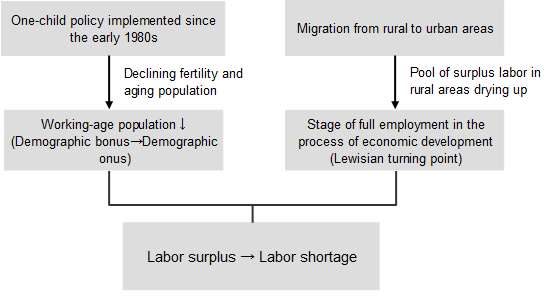
First, as a result of implementing its one-child policy in the early 1980s, China's working-age population, whose share of total population has started to decline after peaking out at around 2010, is expected to decline in absolute terms from 2015. At the same time, the aging of the population will gather pace (Figure 2).
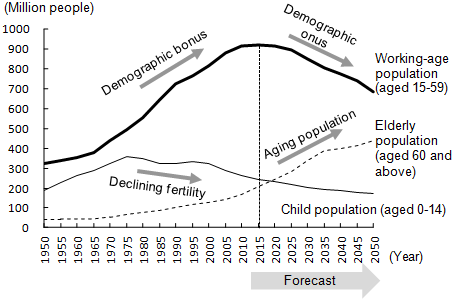
Also, as a result of the rapid migration of the labor force, particularly younger workers, from the rural areas to the urban areas, there are no longer excess workers in the rural areas. The number of migrant rural residents who have left their places of household registration reached 159 million in 2011 ("2011 Report of the Survey of Migrant Rural Workers in China," National Bureau of Statistics of China). Against this backdrop, the Chinese economy appears to have reached a Lewisian turning point, which means that it has reached a stage of full employment in the development process. As evidence of this, no serious unemployment problem has emerged despite the current economic slowdown, in contrast to the previous depression when a huge number of migrant workers lost their jobs after the collapse of Lehman Brothers in 2008 and had to return home. Also, while the growth rate in real wages was consistently and significantly lower than the real GDP growth rate until 1997, subsequently, this trend has been reversed (Figure 3).
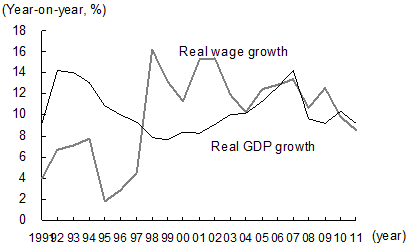
The shift in the working-age population from an upward to a downward trend and the shift from underemployment to full employment are two distinctive concepts and usually occur at different times. Japan, for example, is believed to have achieved full employment in the early 1960s (Ryoshin Minami, Nihon Keizai no Tenkan Ten: Roudou no Kajo kara Fusoku e [The turning point of the Japanese economy: From a labor surplus to a labor shortage], Sobunsha, 1970), but its working-age population did not begin decreasing until around 1995 (World Population Prospects: The 2010 Revision, United Nations). In contrast, it appears that these two turning points have arrived at the same time in China, so the extent of the labor shortage and the subsequent impact on its economy is greater than in other countries.
Rising wages and their impact
The shift from labor surplus to labor shortage, through driving up wages, will have the following effects on the Chinese economy.
First, workers' share of the national income will increase, helping to reduce the income gap. The change in the labor market from a buyer's market to a seller's market will not only lead to rising wages, but also improve workers' rights through shortening working hours and speeding up the reform of the household registration system. Together with a drop in the unemployment rate, these improvements will contribute to social stability.
Second, the regional gap will contract. Given that the labor shortage and rising wages are more evident in coastal areas than in inland areas, the shift of industries from the former to the latter is accelerating, particularly in labor-intensive industries. This shift, which can be considered as the domestic version of the "flying geese formation," has already resulted in a pattern of high growth characterized by higher economic growth in the west (inland areas) than in the east (coastal areas) since 2007. As a result, the regional gap, which had continued to widen in the past, is now narrowing.
Furthermore, inflationary pressure will increase. In fact, if we conduct a regression analysis using data since 1998, with the inflation rate for the current quarter as the explained variable and the economic growth rate three quarters ago as the explanatory variable (taking into consideration the fact that the inflation rate is a lagging economic indicator), a strong correlation can be seen between the two variables, but most of the data since 2010 are located above the regression line, reflecting an upward shift in the inflation rate (Figure 4). While the Chinese government has been reluctant to revalue the renminbi (RMB) out of fear that the resulting slowdown in export growth would hurt employment, this fear would no longer be necessary if full employment has been achieved. Rather, the government may prefer to allow the RMB to appreciate faster in order to curb the inflationary pressure associated with higher wages.
— An Upward Shift in Inflation Has Become Apparent —
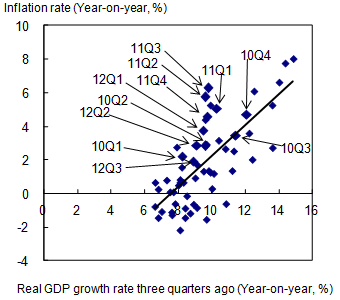
 Estimated period: 1Q 1998-3Q 2012
Estimated period: 1Q 1998-3Q 2012Lowering the potential growth rate
Given the declining working-age population and the arrival of the Lewisian turning point, a drop in the potential growth rate is inevitable in China. Conceptually, the potential growth rate is composed of the contribution of the expansion of labor inputs and the increase in labor productivity, and the latter can be divided further into the expansion of capital inputs and the increase in total factor productivity (TFP) (Figure 5). According to Bosworth and Collins (2008), the average growth rate (which can be regarded as the potential growth rate) of China between 1978 and 2004 was 9.3%, of which the contributions of the expansion of labor inputs, the expansion of capital inputs, and the increase in TFP are estimated to be 2.0%, 3.2%, and 3.9%, respectively. Since these two changes in the labor market will become factors that will restrain the contribution of the expansion of labor inputs and the expansion of capital inputs, the potential growth rate will fall if the increase in TFP remains unchanged.
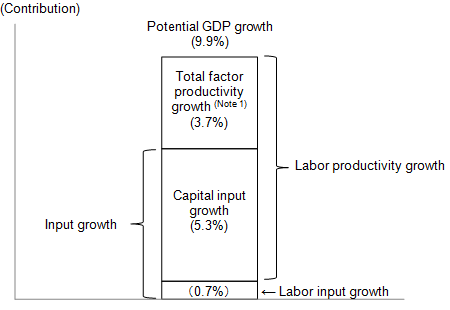
Source: Compiled by the author based on Bosworth and Collins (2008)
First, the turnaround in the working-age population from positive to negative growth means that the demographic bonus will change to a demographic onus. Hitherto, not only has the working-age population continued to increase, but also the savings rate has remained high in a society centering on young people. The increasing working-age population resulted in the expansion of labor supply, and the high savings rate led to the expansion of capital inputs as savings became the source of investments. However, the expected decline in the working-age population and the continued aging of the population will reduce the economic growth rate due to the fall in the supply of labor and in the savings rate.
Also, the arrival of the Lewisian turning point will constrain growth. The supply of labor, which was virtually unlimited in the past, has supported economic growth in China through the following channels. First, the absorption of excess workers in the agricultural sector by the industrial and service sectors has been directly contributing to the expansion of GDP. Also, the shift of the labor force from the agricultural sector, with its low productivity, to the industrial and service sectors, with higher productivity, has improved the productivity of the economy as a whole. Furthermore, the fact that the surplus labor has kept wages at a low level has been working in favor of the group with high capital income, which in turn has led to high savings and high investment. However, the achievement of full employment means that the supply of labor to the industrial and service sectors will decrease. This, together with a decline in the savings rate, should result in a decline in the potential growth rate.
There are clear signs suggesting that China's potential growth rate might have already declined. One of these is the recent divergence between the relatively high job-offers-to-seekers ratio (which represents the balance between supply and demand in the labor market) and the relatively low economic growth rate (Figure 6). In general, the more the growth rate exceeds (or falls below) the potential growth rate, the higher (or lower) is the job-offers-to-seekers ratio, as the balance between labor supply and demand tightens (loosens). If the potential growth rate is constant, a lower growth rate should decrease the job-offers-to-seekers ratio, as the balance between supply and demand loosens in the labor market. However, if the potential growth rate also falls together with the actual growth rate, the job-offers-to-seekers ratio should remain high as it is today, as the balance between labor supply and demand does not widen.
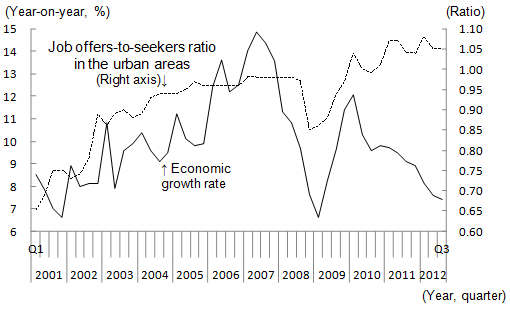
Sources: Compiled by the author based on data from the National Bureau of Statistics of China and the Ministry of Human Resources and Social Security.
Shift in the economic development pattern
While the loss of the demographic bonus and the achievement of full employment mean that growth driven by the quantitative expansion of factor inputs such as labor and capital will be difficult, it also implies that China will be freed from the constraint of having to create a large number of jobs.
From 1991 to 2011, China's GDP growth rate reached 10.4% per annum, while its employment growth rate remained at only 0.8%. The co-existence of a high economic growth rate and low employment growth has come to be known as "jobless growth" in China, and many economists regard this as a serious economic problem. The government has also been placing priority on the development of labor-intensive industries to secure employment. However, the fact that the GDP, showing output, has grown by as much as 10.4% annually, while employment, representing labor input, has increased by only 0.8% annually means that the annual growth in labor productivity has reached 9.6%, significantly contributing to economic growth. From this perspective, "jobless growth" can be reinterpreted as "growth without depending on job growth" (that is, growth by raising labor productivity). If full employment is achieved and the working-age population starts to decrease, growth from expanding employment would become increasingly difficult, if not impossible, then an increase in labor productivity—a rise in TFP in particular—will become the most important element to support the economic growth rate.
Against this backdrop, the Chinese government has begun to make the top priority of its economic policy the "shift in the economic development pattern," primarily a shift from growth based on the expansion of inputs to growth based on higher productivity, instead of focusing on job creation as in the past. To improve productivity, the government encourages indigenous innovation by Chinese companies. In addition, the government regards the following seven strategic emerging industries as areas to focus on cultivating: 1) energy conservation and environmental protection; 2) next-generation information technology; 3) biotechnology; 4) high-end equipment manufacturing; 5) new energies; 6) new materials; and 7) new energy automobiles.
Not only government policies but also market forces are encouraging a shift in the economic development pattern. As a result of the rising wages associated with the labor shortage, companies have to work on investments in saving labor and cultivate new business areas to enhance their competitiveness.
Based on these efforts of the government and companies, China is upgrading its industrial structure by moving resources out of labor-intensive industries to higher value-added areas. As symbolized by the fact that China has already become the world's largest producer of automobiles and crude steel, the backbone of the Chinese manufacturing industry has been shifting from light industries to heavy industries.
Impact on the world economy
Given that China is the world's largest exporting country and the second largest importing country, the rapid changes in its labor market and the resulting shift in its economic development pattern will also have a significant impact on the world economy.
First, in international trade, these changes will alter the relative prices of products and, in turn, the terms of trade (the relative price of exports to imports) of countries involved through changes in China's export and import structures.
China has been increasing its exports of labor-intensive products, making use of the comparative advantage of its abundant labor force, while importing capital- and technology-intensive products such as machinery and components from abroad. In this process, China's terms of trade deteriorated in the form of "falling prices for exported goods and rising prices for imported goods," while those of its trading partners improved. This means that China in effect transferred income to its trading partners.
However, as labor moves from a surplus to a shortage, China's comparative advantage is shifting from labor-intensive products to capital- and technology-intensive products. As China's imports of capital- and technology-intensive products will be replaced by goods domestically manufactured, while its exports of labor-intensive products will be curbed, both the supply of labor-intensive products and the demand for capital- and technology-intensive products will decline in the international market. As a result, the relative price of labor-intensive products to capital- and technology-intensive products will rise, and, in turn, China's terms of trade will improve. While this change in relative prices will be beneficial for developing countries that mainly export labor-intensive products and import capital- and technology-intensive products, it will hurt developed countries that primarily export the latter and import the former.
At the same time, in terms of direct investment, the change in China's comparative advantage is accelerating the shift overseas of labor-intensive products due to rising wages and the higher exchange rate. The industrial restructuring in China, which involves large-scale relocation of factories beyond its national borders, will provide a good opportunity for Southeast Asian countries and emerging countries such as India with low wage costs to accelerate their industrialization based on the inflow of direct investments. In 10 years, products made in China that are on the shelves of 100-yen shops in Japan, for instance, may disappear and be replaced by products made in these other countries.
The original text in Japanese was posted on October 30, 2012.


